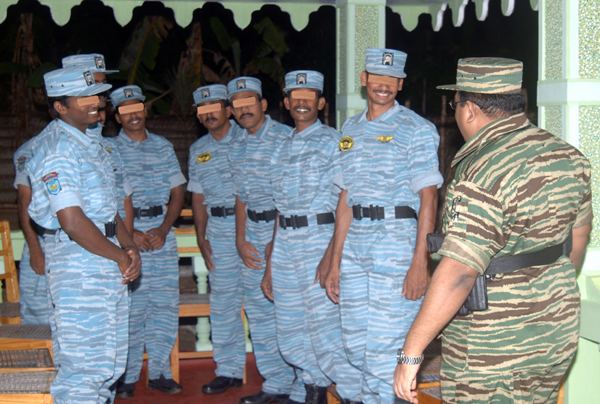 |
| LTTE leader Vellupillai Pirapaharan meeting Air Tigers before setting off on their mission deep behind Sri Lankan lines. Photo LTTE |
Reliable details of the combined air and land attack launched by the Liberation Tigers of Tamil Eelam (LTTE) on the Anuradhapura air base of the Sri Lankan Air Force early in the morning of October 22, 2007, indicate that it was neither an act of desperation as projected by the embarrassed Sri Lankan military spokesmen nor an act of needless dramatics as suggested by others.
It was an act of unbelievable determination, bravery and precision successfully carried out by a 21-member suicide commando group of the Black Tigers - significantly led by a Tamil from the Eastern Province - with the back-up support of two planes of the so-called Tamil Eelam Air Force.
Reliable Western sources say that no other terrorist organisation in the world would have been capable of organising such a raid, which had been preceded by painstaking intelligence collection, planning and rehearsal.
The commandoes, divided into groups, infiltrated into the air base from two directions and, within 20 minutes, took the security guards by surprise, overwhelmed them, seized their weapons and communication equipment, neutralised a radar and an anti-aircraft gun position and then intimated their headquarters that they were in effective control of the air base.
Only then the two aircraft of the LTTE's air wing flew to Anuradhapura and dropped two bombs on the base and flew back safely to their hide-out.
The commandoes remained in effective occupation of the base from 3 AM to at least 9 AM. During this period, they blew up three helicopters, two fixed-wing aircraft - one of them a trainer - and three unmanned drones.
After losing communication with the air base, the Sri Lankan Air Force base at Vavuniya sent one of its helicopters to Anuradhapura to find out what had happened. As it was approaching the air base, it was shot down by the LTTE commandoes manning the anti-aircraft gun in the air base.
The commandoes also blew up an ammunition storage depot in the air base and damaged its runway.
It is learnt that the Black Tiger commandoes remained in communication with their headquarters till 9 AM. Thereafter, all communications ceased, indicating thereby that all of them had either been killed by the Sri Lankan Security Forces or had committed suicide to avoid falling into the hands of the Sri Lankan security forces, who had counter-attacked the base.
Thirteen SLAF personnel were killed, nine inside the base and four in the helicopter crash.
The LTTE has been silent on the fate of the commandoes. However, it has released their personal particulars.
Two Lieutenant-Colonels, six Majors, 12 Captains and one Lieutenant rank Black Tiger members took part in the operation. A Lieutenant-Colonel who led an attack team was from Trincomalee, two of the members, a Major and a Captain, were from Batticaloa, one from Mullaiththeevu, one from Mannaar, three from Ki'linochchi and eleven members from Jaffna .Three Captains were women.
Initial reports of the raid had indicated that the raid started with an air attack by the LTTE's aircraft and that it was only thereafter that the commandoes had infiltrated into the air base by taking advantage of the confusion.
Subsequent reports, however, indicate that the Black Tigers initially infiltrated the base and took control of it and that it was then that the air raid was launched more to test the capability for co-ordination between the air wing and the Black Tigers than to cause damage to the base. Since the Black Tigers were already in effective control of the base, they did not need any air support.
Embarrassed by the spectacular display of the LTTE's prowess, the Sri Lankan authorities have been trying to play down the successes of the LTTE operation.
They claim that only two helicopters and one fixed wing aircraft were damaged and another helicopter was destroyed when it crash-landed due to technical reasons.
The Colombo correspondent of the "Daily Telegraph" of London has reported that the Black Tigers destroyed an expensive Beechcraft surveillance plane worth £14 million, two Mi17 helicopters, two Mi24 helicopters, three unmanned aerial vehicles, a K-8 jet and eight PD6 propeller trainer aircraft.
The Anuradhapura air base was essentially used by the SLAF as a training base. The training command of the SLAF was located there.
In addition, it was also providing intelligence support to the SLAF and the Navy through the sophisticated Beechcraft plane fitted with equipment for aerial photography and the collection of electronic and technical intelligence and the unmanned drones.
Instructors from Pakistan, China and Israel were periodically attached to the base.
The helicopters destroyed by the Black Tigers were being used as helicopter gun ships or for VIP transport. While the damage sustained by the SLAF is considerable in money terms and reduces its capability for intelligence collection for air and naval operations, its impact on the SLAF's capability for air strikes over the LTTE controlled areas would be limited.
The successful operation would seem to have been launched by the LTTE in retaliation for the recent operations of the Sri Lankan Navy against the transport ships of the LTTE and the air strikes of the SLAF over LTTE positions in the Northern Province.
It once again underlines the LTTE's reputation as an organisation with a tremendous tenacity of purpose, grit and sophistication in thinking and planning. Its recent set-backs have not weakened its morale.
They have only redoubled its determination to keep fighting for its political objective unmindful of the losses in the Eastern Province.
The writer is Additional Secretary (retd), Cabinet Secretariat, Govt. of India, New Delhi, and, presently, Director, Institute For Topical Studies, Chennai. E-mail: [email protected]
